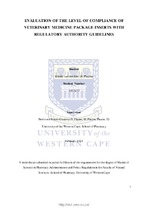| dc.description.abstract | Background: Veterinary medicines play an imperative role in the diagnosis, prevention and
treatment of animal diseases. Many veterinary stock remedies in South Africa are available to
the public without the intervention or supervision of a veterinarian or healthcare worker.
Therefore, the accompanying package insert with product information and directions for use is
central in promoting the safe and effective use of stock remedies. Information such as the
dosage, warnings, precautions and storage instructions are essential to assist the user in their
treatment decision-making. While local regulatory authority guidelines prescribe and control
the minimum information that should be available in the package insert or product label, it is
questioned whether the information contained in package inserts of products on the market
complies with these regulatory requirements.
Methodology: Using simple random sampling of veterinary stock remedies, 159 package
inserts or product labels from various animal health companies were selected and evaluated
against the prescribed labelling guidelines of the local regulatory authority responsible for the
registration and control of stock remedies. The contents of each package insert or label in the
sample were assessed for the presence of the prescribed information statements and were
accordingly classified as non-compliant, partially compliant or compliant.
Results: Among the 159 package inserts, 48 were for antimicrobials, 49 for ectoparasiticides,
44 for anthelmintics and the remaining 18 for endectocides. It was observed that none of the
package inserts met all of the criteria and that the package inserts were inadequate in many
aspects. The average percentage of compliance was 69.43%, with a range of 36.21% to 87.93%.
Conclusion: The study indicated that many package inserts do not fully comply with the
prescribed regulatory guidelines and that information related to the safe and appropriate use of
stock remedies is insufficient. | en_US |

